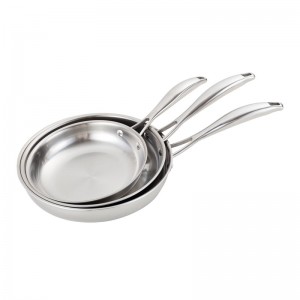Key Considerations
Grade of Stainless Steel
Oftentimes, the grade of stainless steel is stamped on the cookware, with 18/10 being the most commonly used grade for good quality cookware. This fraction tells you the percentage of chromium and nickel in the alloy used—18/10 contains 18 percent chromium and 10 percent nickel and will resist rust while also retaining its shine and polish.
Weight
While the ideal thickness of a good pan is subjective to a cook’s preference, a quality stainless steel pot will have a certain heft in your hand. A weighty pot means that it won’t move around on the stove, and its weight also means it is more likely to distribute heat evenly and less likely to have “hot spots.” Heavier pans also stand up well to the rigors of daily use and are less susceptible to dents, warping, and dings than lighter, thinner pans.
Core and Construction
Look for a fully-clad pan with an aluminum or copper core. Good stainless steel cookware will have an aluminum or copper disc sandwiched between layers of stainless steel to aid in conducting heat. The full layers of stainless steel that make up the bottom and sides of the pot are called “cladding,” and the number of layers will be described by its “ply.” The most common is tri-ply, which describes two layers of stainless steel with an aluminum or copper core, but pans can also come in 3-ply or 5-ply (commonly referred to as “multi-clad”). Another quality feature is riveted stainless steel handles—they are more secure than spot-welded handles, which are more likely to come off with heavy use.
Heating Capacity
Most stainless steel cookware is also oven-safe, but its heating capacity depends on the quality of the cookware. Less expensive, lighter pans may only be oven-safe to 350 degrees, and higher-quality, heavier pans can often withstand temperatures well above 500 degrees (including use under the broiler). Be sure to always check the manufacturer’s instructions to determine the maximum heating capacity of your cookware (and their lids) before use.
Versatility
Stainless steel is great for all-purpose cooking—it can be used for braising and browning as well as creating sauces and soups. The non-reactive properties of stainless steel make it ideal for cooking sauces with acidic ingredients (think tomato sauce or meats stewed in wine). Many stainless steel pieces are oven-safe, allowing you to finish a dish under the broiler if needed.
Post time: Feb-16-2023





